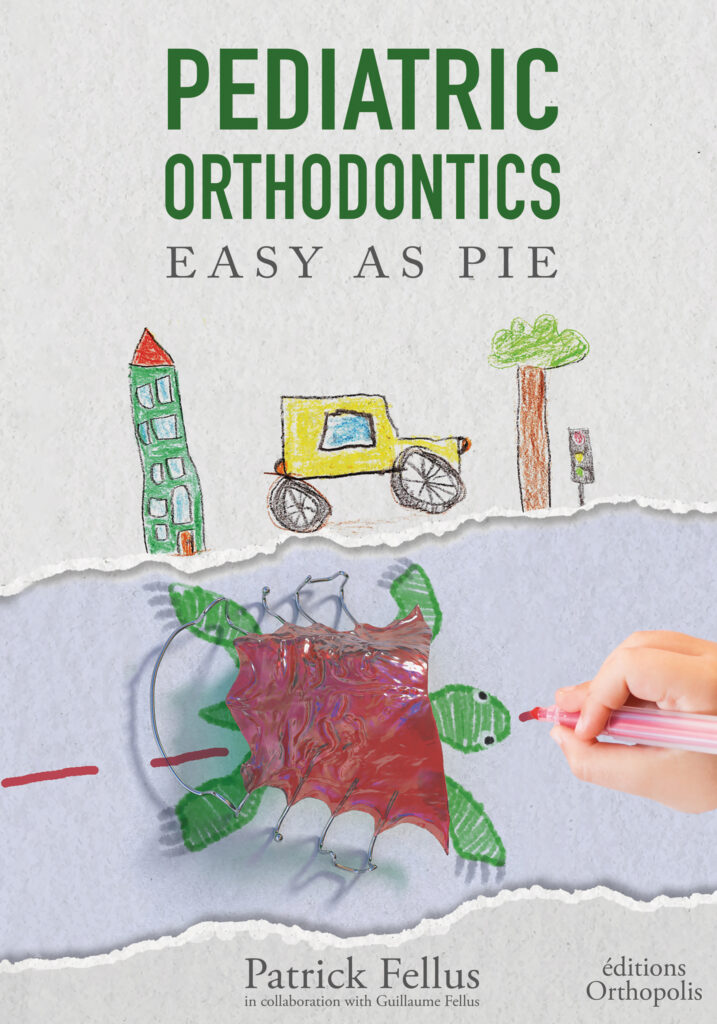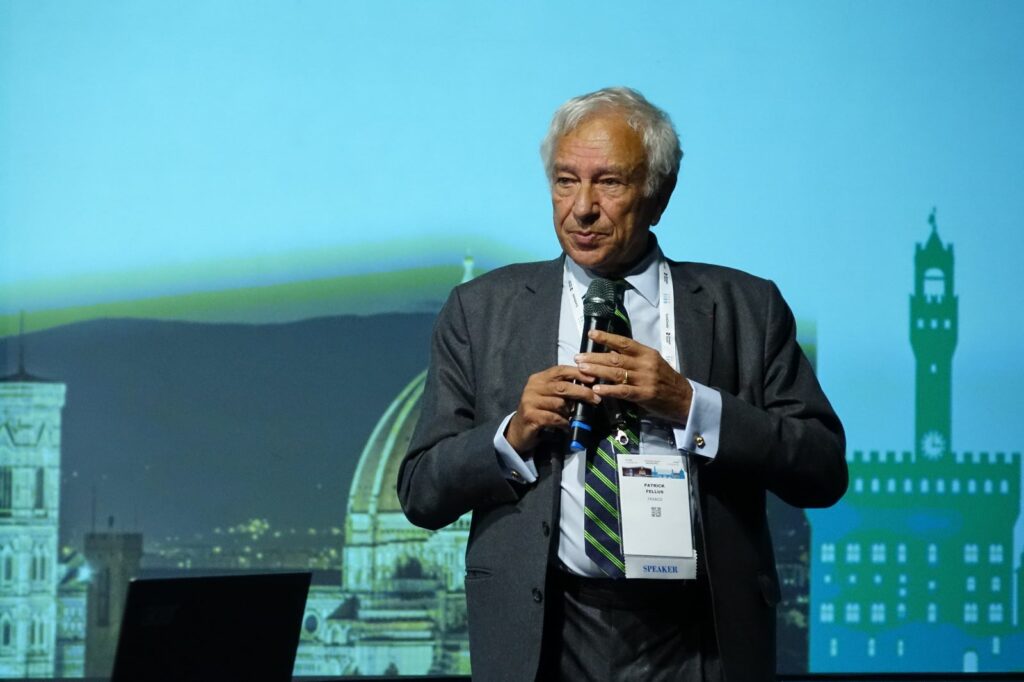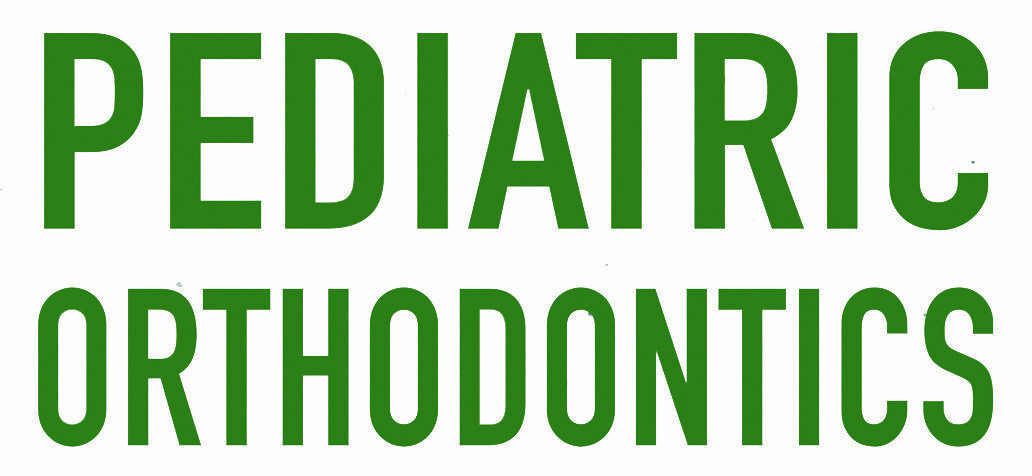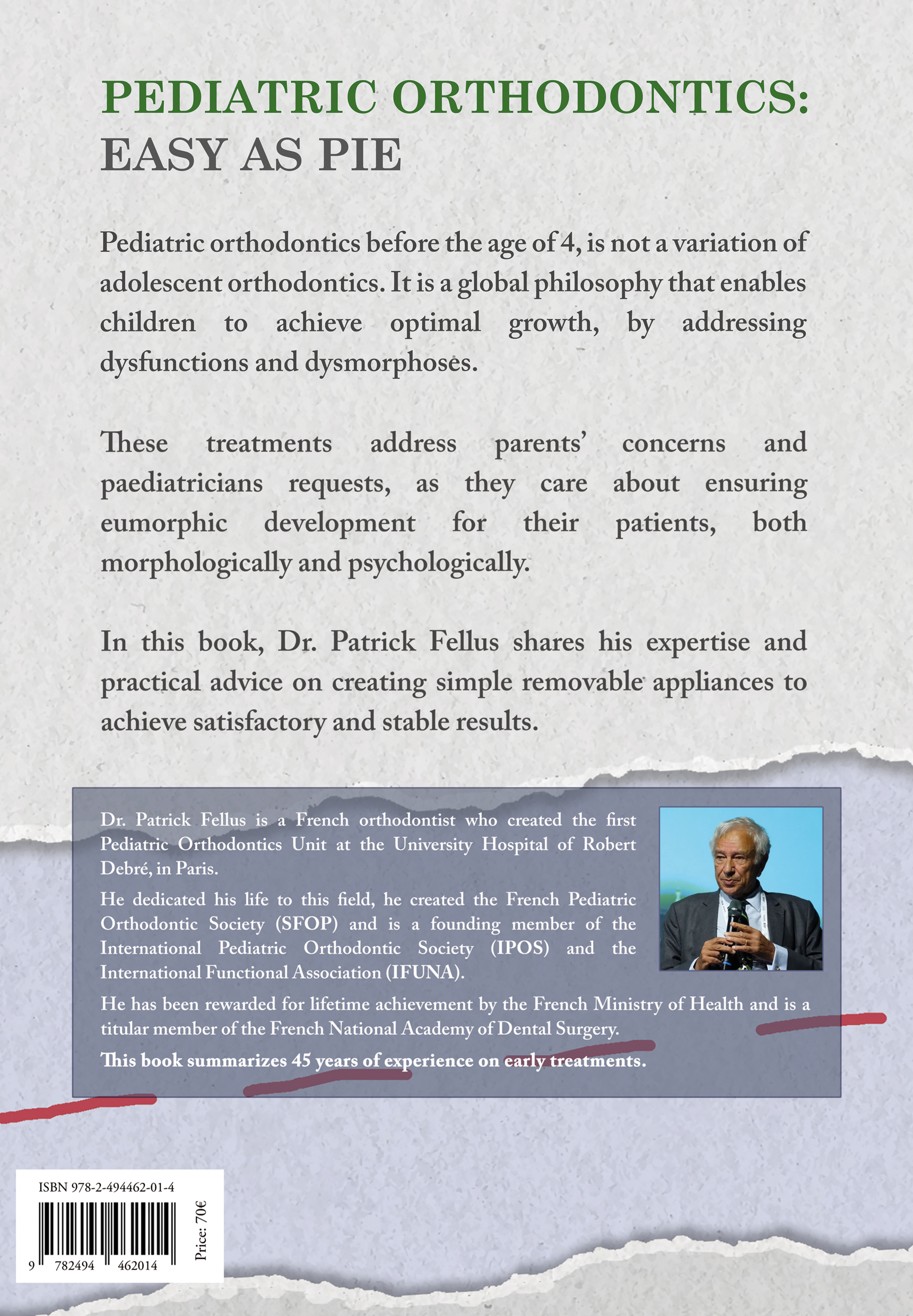Your Essential Clinical Guide
Find out about Dr. Fellus' amazing work.
It's a 170-page summary of 45 years of clinical practice.
Foreword by Isabelle Filliozat.
In collaboration with Guillaume Fellus.
Pioneering Pediatric Orthodontics:
Your Essential Clinical Guide
Find out about Dr. Fellus’ amazing work.
It’s a 170-page summary of 45 years of clinical practice.
Foreword by Isabelle Filliozat.
In collaboration with Guillaume Fellus.

The Book
Context
The book, built on 45 years of pediatric orthodontic research, emphasizes treating maxillo-mandibular dysmorphosis early, ideally once temporary dentition sets. Poor teeth positioning often reveals muscular imbalances, which can be addressed around age 4. Persisting primary swallowing patterns can lead to facial growth disorders. Functional problems manifest in various bite issues, but merely correcting teeth positioning tackles the visible aspect of deeper functional challenges. Addressing these issues early promotes healthier development and social integration for children. The book serves as a guide for various dental practitioners in early child orthodontics.
Dr. Patrick Fellus, MD, DDS
Dr. Patrick Fellus is regarded as one of the pioneers of pediatric orthodontics in France and globally. He has dedicated his entire career to early orthodontic treatments, notably at the Robert Debré Hospital. In 2010, he founded the French Society of Pediatric Orthodontics in response to the need to advance the discipline. In 2020, he played a part in establishing the International Society of Pediatric Orthodontics to address these challenges on a global scale. With 45 years of clinical practice under his belt, the author-speaker-innovator now devotes most of his time to passing on his knowledge.

Content. Click on chapters to see detailed content.
Introduction: Over the last 15 years, orthodontic treatments are being started at younger ages, with children in primary school frequently seen with orthodontic appliances.
Guidelines: A 2002 ANAES publication in France recommended:
- Screening for orthodontic needs before age 6.
- Various orofacial dysfunctions should be warning signs leading to a more in-depth examination.
Implementation & Acceptance:
- The guidelines are largely unknown by the general public and underused by practitioners.
- The belief that orthodontic issues are primarily genetic has led professionals to delay interventions until after growth is complete.
- External factors, beliefs, and attitudes can influence genetic expression.
Pediatric Orthodontics in the US: Orthodontists largely delegate early treatment to pedodontists, who often understand and communicate better with young children.
Importance of Early Treatment:
- Pediatric orthodontics isn’t a trend; it’s crucial for addressing dysfunctions and dysmorphosis.
- Addressing oral dysfunctions early offers benefits beyond just dental corrections; it aids in a child’s psychological development.
Approach to Treatment:
- Orthodontic practices should change from a top-down approach (where the brain controls the process) to a bottom-up one (where sensory reactions influence the process).
- The treatments should be easy and non-intrusive for children, requiring minimal effort.
Administrative & Financial Aspects (specific to France):
- The French National Health Authority supports treatments during the early years, providing coverage for three semesters out of six.
- Simple orthodontic issues can typically be resolved in this time frame.
Post-Treatment: It’s vital to monitor progress and potential relapse during and after treatment.
In essence, the text emphasizes the importance of beginning orthodontic treatments at a younger age to address issues before they become more complex. While these guidelines were established in France, the concept can apply universally.
Introduction to Treatment:
- Pediatric orthodontic treatment should begin with a detailed understanding of the child’s oral condition and their specific needs.
Consultation with Parents:
- Build trust and rapport with parents. Provide a clear treatment plan and highlight the importance of their involvement.
Age of Treatment Initiation:
- Start early: Age 3-4 for facial growth tracking and Age 6-8 for intervention, based on the child’s development.
Child Engagement:
- Engage children with games or visual elements, ensuring they understand their role in the treatment.
Bi-endoalveolar Assessment:
- Check for cheek contraction by placing an auricular in the mouth and observing swallowing patterns. If buccinators are active, initiate myofunctional therapy.
Palate Symmetry:
- The palate’s shape refines diagnosis. Adjustments involve grinding the appliance during expansion for symmetrical growth.
Ogival Palate:
- Careful with rapid expander activation to prevent unwanted contact. Grind the ogival region in sync with lateral expansion.
Lingual Rehabilitation:
- Expanders reveal lingual dynamics after swallowing, ensuring the median slit mark on the tongue is visible.
Stopping Sucking Habits:
- Such habits delay oral physiological processes. Transition from bottle-feeding at age 2 and consider strategies for pacifier elimination post the first birthday.
Thumb Sucking:
- While a physiological action, most cease the habit by age 5. Treatment for open bites from thumb sucking can often wait, as they may resolve on cessation.
Inclined Plane Usage:
- Effective for cases of retracted mandible.
- Corrects up to 15mm overjet, avoiding surgery later in life.
- Best for Class II misalignments by controlling condylar growth.
- Inclined plane acts as an engine, powered by swallowing saliva.
- Individualizing the condylar incline enhances comfort.
- Treatment success hinges on a practitioner’s skills in functional re-education.
Building and Adjusting the Model:
- Wax model key for treatment success.
- Fit ensures interference-free mandibular trajectory.
- Articulating paper aids in adjusting the inclined plane’s length.
Treatment Progression:
- Treatment can be progressive or done in one go.
- Overjet dictates adjustment approach; greater retraction might need stages.
- Monitoring involves checking bone growth and adjusting the incline.
Potential Incidents & Resolution:
- Open bites indicate poor motility; need to reassess protrusion plane.
- Check condyle positioning at treatment end to avoid double occlusion.
- Proper occlusion and centered condyle relationship crucial for function and aesthetics.
Benefits of Inclined Plane Over Extra-Oral Forces:
- Avoids issues associated with external forces.
Molar Planes:
- Useful in both transverse and antero-posterior directions.
- Made strong yet not too thick to avoid meal disturbances.
- Helps in correcting occlusion issues and balancing mandibular muscles.
Transverse Direction Anomalies:
- Simple expansion devices rectify lateral sector teeth misalignments.
- Molar planes assist in rectifying occlusal anomalies.
- Height adjustments of molar planes can correct occlusion plane loss.
Case Examples:
- Various clinical cases demonstrate the efficacy of the techniques.
When addressing pediatric orthodontics, it’s essential to consider the behavioral and physiological aspects of children’s development.
Swallowing and Speaking Mechanics: Children often revert to old swallowing programs, making it challenging when they have to clench their teeth, retract their tongue to avoid a bite, swallow, and then continue speaking. However, two simple exercises can assist in rectifying this:
- Counting from 1 to 20 daily with clenched teeth to improve lip dynamic.
- Counting again with clenched teeth between each number, but faster.
Benefits of the Froggymouth: As a result, the tongue finds its natural place behind the dental arches. Surprisingly, appliances can improve diction, which is advantageous before starting primary school. After mastering the routine, the appliance is needed less frequently.
Importance of Rehabilitation: It’s crucial to understand that treating dyspraxia is multi-faceted.
Nature’s Role in Rehabilitation: If a patient continues mouth breathing, the tongue remains distant from the palate. Fortunately, rehabilitation often happens naturally due to connectionism. Glial cells play a vital role in learning, enhancing the information across neural circuits.
Breathing Rehabilitation: Simple exercises can promote nasal breathing:
- Deep nasal breaths.
- Maximum inspiration, activating nostrils.
- Recognizing scents to understand the passage of air through nasal cavities.
Challenges and Failures in Rehabilitation:
- Ignoring contraindications.
- Non-compliance with instructions, like not wearing the appliance consistently.
- Lack of post-treatment follow-up.
- Non-acquisition of praxis modifications.
- Condylar unresponsiveness to growth forces, which can lead to TMJ issues.
- Treatment discontinuation.
It’s worth noting that although these rehabilitation tools sound straightforward, they require proper diagnosis and expertise, honed over years of clinical practice.
For Whom it is written
While this book is primarily tailored for General Practitioners, Orthodontists, and Pedodontists, speech therapists, myofunctional therapists, physiotherapists, and osteopaths will also find it highly beneficial, emphasizing the pivotal role of transdisciplinary cooperation in pediatric orthodontics.


